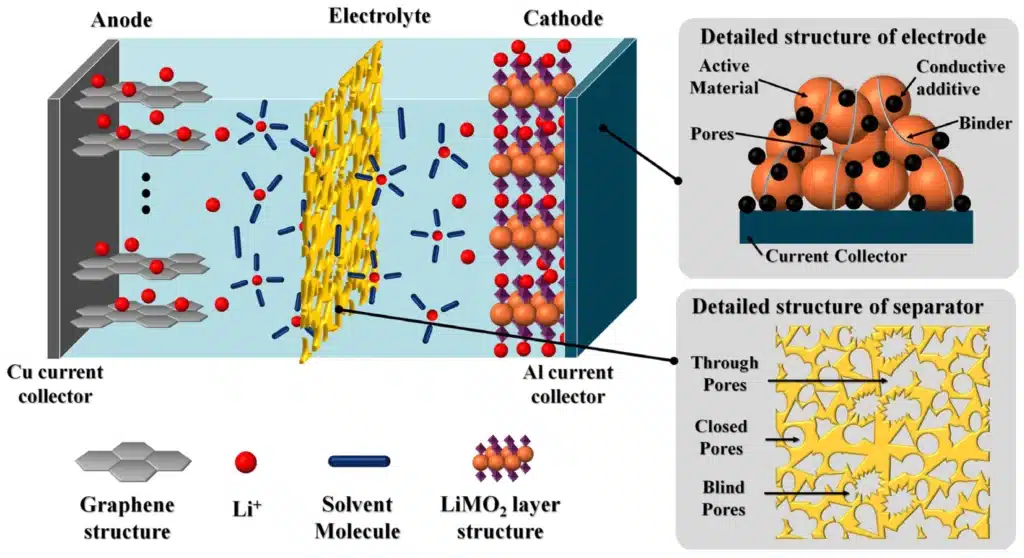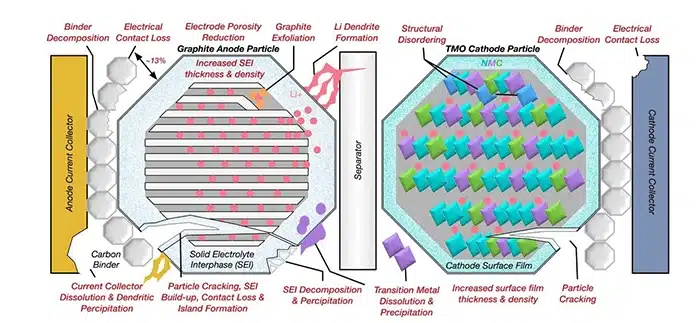Have you found that your device is not durable anymore? You used to only need to charge it once a day, but now you need to charge it twice. I believe that many people have experienced this battery life anxiety problem. Behind these phenomena, there is often a common reason: battery degradation.
This article explores why lithium batteries degrade and how we can slow down this process as much as possible. Battery degradation is a natural and inevitable physical and chemical process, just like we age.
Table of Contents
ToggleWhat is lithium battery degradation

Battery degradation is like how we humans age and lose strength as we did when we were young. Lithium batteries can store a lot of energy at first and can also output energy very effectively. But as time goes by, irreversible changes occur inside the battery, causing its ability to store energy and its efficiency in outputting energy to decrease. This is battery degradation.
The specific manifestations of a degraded battery are as follows:
Capacity decay, for example, the capacity of a new mobile phone is 2500mAh, but after 1 to 2 years, its storage capacity may be only 80%, that is, 2000mAh. You will feel that the mobile phone is becoming less and less durable and the battery life is getting shorter.
The internal resistance of the battery increases. You can think of it as a water pipe that becomes thinner or clogged. When you run large games or complex applications that require the battery to quickly supply a large amount of power, the battery energy supply may not be able to keep up. When the current passes through a greater resistance, more heat is generated.
Battery health decreases. A new battery may have a health of 100%, but an aged battery may only have a health of 85%.
Why do lithium-ion batteries degrade

Lithium-ion battery degradation is not caused by a single reason, but the result of multiple factors. The following are the core influencing factors:
The more charge and discharge cycles, the faster the battery degrades. You can think of each complete charge and discharge of the battery (for example, from 0% to 100% and then used up) as a working cycle. Each time the battery is charged and discharged, the chemicals in the battery will undergo slight changes and losses. Just like a pair of shoes, the more times you wear them, the faster they will wear out.
Time passes, calendar aging occurs. Batteries also age naturally over time. Over time, the battery’s chemicals will spontaneously undergo some slow reactions, causing performance to decline.
High temperature is the number one killer of batteries. High temperature will sharply accelerate all chemical reactions inside the battery that lead to aging. At the same time, charging lithium batteries at extremely low temperatures is very harmful and may cause some permanent damage to the battery.
Keeping the battery fully charged for a long time is also an important factor. It will put extra pressure on the lithium battery and accelerate the aging of the battery.
Long-term deep discharge is also called deep discharge. If you often use up the battery completely, or even use it until it automatically shuts down, and then leave it without charging, it will also harm the battery.
How to effectively delay battery degradation
Although we cannot completely prevent battery aging, we can significantly slow down the battery aging process through some good usage habits.
Optimize your charging habits. Avoid two extremes, avoid overcharging to 100% and avoid draining to 0%. The best charging habit is to charge and discharge shallowly. The most comfortable range for lithium batteries is about 20% to 80%. Of course, you don’t have to worry too much about this.
Fast charging is indeed convenient and can shorten your waiting time. If you are not in a hurry, you can choose to charge at normal speed. The current fast charging technology itself is very safe, but you must pay attention to heat dissipation.
Keep away from high temperatures, this is the most important thing. Do not leave your device in a high temperature environment for a long time, such as in a car exposed to the sun in summer, on a window sill under direct sunlight, etc.
If you have a device that you plan to leave idle for a few months or even longer, the best practice is to charge it to about 50%, then shut it down and store it in a cool, dry place.
Try to use the original charger of the device or a high-quality charger with brand certification. Poor-quality chargers may have unstable voltage and current, which will not only lead to poor charging effect, but also damage the battery.
Common misunderstandings and answers
Lithium batteries are constantly developing. Some of the old concepts may no longer be applicable. Here are some common misunderstandings and answers.
- A new battery does not need to be fully charged for 12 hours. This is for traditional nickel-cadmium batteries. Today’s lithium batteries have aged. Just use it normally after you receive the device.
- Today’s batteries do not have a memory effect, so you don’t need to use them up before recharging them. Old nickel-cadmium batteries do have a memory effect, but newer batteries can be charged as you use them, and are more friendly to lithium batteries.
- Fast charging does not necessarily seriously damage the battery. Qualified fast charging technology, whether it is the charger or the device itself, has many built-in safety protection mechanisms.
- There is no harm in charging mobile phones and other devices overnight. When the battery is fully charged to 100%, it will automatically stop charging or switch to a very small current to trickle charge to maintain the power.
- Today’s lithium batteries do not need calibration. Their operating systems will automatically learn and adjust the battery level display.
Conclusion
Battery degradation is a natural phenomenon, just like people will slowly age, and it cannot be completely avoided. But the good news is that through some scientific usage methods and habits, you can definitely significantly delay this process, making our batteries last longer and accompany us longer.
